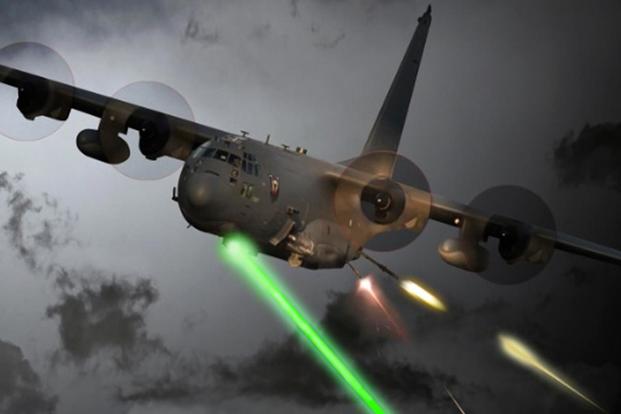The Air Force no longer plans on installing and operating a high-energy laser weapon on a special operations gunship due to "technical challenges," an official said, bringing the service's latest attempt at an airborne directed-energy system to an end after years in development.
A spokesman for Air Force Special Operations Command confirmed to Military.com that its Airborne High Energy Laser, or AHEL, missed its "available integration and flight test window" for operations from an AC-130J Ghostrider gunship amid open-air ground testing.
AFSOC had previously stated in November 2023 that airborne testing of the AHEL would commence in January 2024 and finish in June. As The War Zone noted, that window already represented a delay from a previously promised testing period of fiscal 2021.
While the AHEL achieved " significant end-to-end, high-power operation" during ground tests, the missed integration and flight test window prompted AFSOC to "[refocus] on ground testing to improve operations and reliability to posture for a successful hand-off for use by other agencies," the command spokesman said.
In short, the AHEL may live to fight another day as part of a different Air Force agency's directed-energy efforts, but it will likely never see battle from the catbird seat of a special operations gunship.
Air Force Special Operations Command has pursued efforts to mount a high-energy laser on a fixed-wing aircraft since 2015, with Lockheed Martin receiving a contract in January 2019 to support the integration and demonstration of the AHEL on an AC-130J. The defense giant delivered the system to the Air Force in 2021.
The AHEL was envisioned as a laser system employed for what's termed low-probability-of-detection use on a complex battlefield to back up special operators against targets such as "communication nodes, light-to-medium duty vehicles and power infrastructures," according to U.S. Special Operations Command's fiscal 2025 budget request.
"Without the slightest bang, whoosh, thump, explosion or even aircraft engine hum, key targets are permanently disabled," as then-AFSOC commander Lt. Gen. Brad Webb put it in 2017 as he described the tactical benefits of the notional AHEL. "The enemy has no communications, no escape vehicle, no electrical power and no retaliatory [intelligence, surveillance and reconnaissance]."
An AHEL on a gunship wouldn't have been the first time the U.S. military mounted a laser on a fixed-wing aircraft. In 2010, the Air Force's Boeing 747-based Airborne Laser Testbed successfully downed a ballistic missile during a test off the coast of California.
Unfortunately, there appears to be no funding left to make Webb's vision a reality: According to U.S. Special Operations Command budget documents, funding for the AHEL was zeroed out as part of the command's fiscal 2025 budget request, down from $3 million requested in fiscal 2024 and $15.387 million requested in fiscal 2023.
As for the AHEL's future life as part of another laser weapons system, it's unclear what a "successful hand-off for use by other agencies," as AFSOC put it, will look like.
One possibility is that the technological capabilities developed under the AHEL effort will transfer over to the Self-Protect High-Energy Laser Demonstrator, or SHiELD, program that seeks to mount a laser system on a fighter jet to neutralize incoming missiles, testing of which was delayed for years due ongoing technical challenges and the COVID-19 pandemic.
Testing for the SHiELD system is now scheduled for sometime in 2024, as Breaking Defense previously reported.
Related: A Moment of Truth for the Army's Chief Laser Weapon












